Eggceptional Eggs-periments – Incredible Egg Geodes
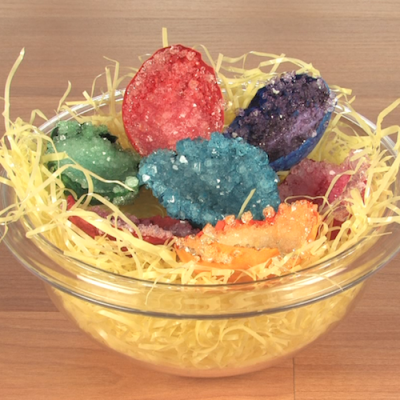 Do you love crystals? Are you looking for a creative way to color Easter eggs? How about a little kitchen science to kick off the spring weekend? This activity covers all three.
Do you love crystals? Are you looking for a creative way to color Easter eggs? How about a little kitchen science to kick off the spring weekend? This activity covers all three.
A crystal geode takes thousands of years to grow a crystal inside. That’s a lot of waiting, not to mention you have to find the geode and then crack it open. I’m not sure anyone has a spare thousand years on their hands. If so, I want to meet them.
If you are not that patient or want to work that hard for your crystals, an Egg Geode is eggs-actly the right geode for you. They require some patience and time, but not anywhere near what a real geode takes.
Materials
- Egg
- Paintbrush
- Glue
- Food coloring
- Alum powder (look in the spice section of your local grocers)
- Water
- Scissors
- Paper towels
- Bowl
- Beaker/glass
- Spoon
- Pushpin
Activity
1. Start with getting the yolk and goo out of the egg. Use a pushpin to carefully poke holes at either end of the egg.
2. Put your mouth on one hole and carefully blow out the egg insides through the other. You can blow it into a bowl to scramble later or throw it out.
3. Carefully cut the eggshell in half, down the egg’s length, with a pair of scissors. Pull off any little pieces around the edges.
4. Keeping caution and careful movements, wipe out the inside of the egg with a paper towel. Get it as clean and dry as possible.
5. Drop a small amount of glue into the egg and use a paintbrush to spread it around. Try to cover the entire interior surface, all the way up to the edges, of the egg with glue. Add more glue if needed.
6. Before the glue dries, cover it generously with alum powder.
7. Wait for it all to dry overnight. Here is where you can throw caution to the wind and pick up some patience.
8. Come back the next day and bring two cups of water to an almost boiling point. (That’s 473 mL to all scientists and everyone outside the U.S.). Pour the heated water into a beaker or glass. Add 30-40 drops of food coloring and 3/4 cup of alum powder and stir.
9. Let the solution cool for about 30 minutes.
10. Once the colored alum solution has cooled, place the egg, opening up, into the solution. Push the egg to the bottom of the beaker with a spoon and allow the egg to sit in the solution for 12-15 hours. That’s a long time, right? Good thing you practiced patience by waiting for the glue to dry earlier.
11. After the 12-15 hours have passed, check out your egg. It’s grown crystals! Carefully remove the egg and place it on a paper towel or drying rack to finish the geode-creation process.
For the science behind this activity and how it works, visit our Incredible Egg Geode experiment page.



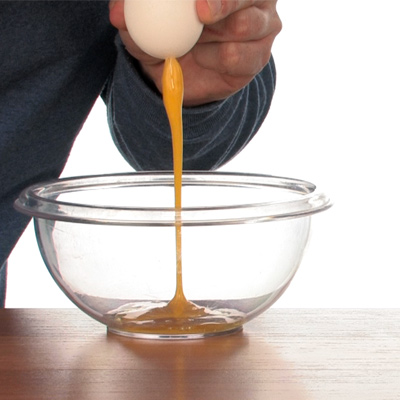
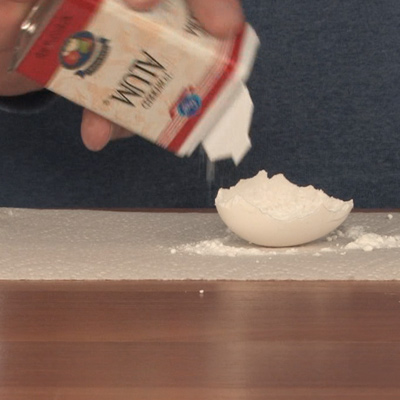
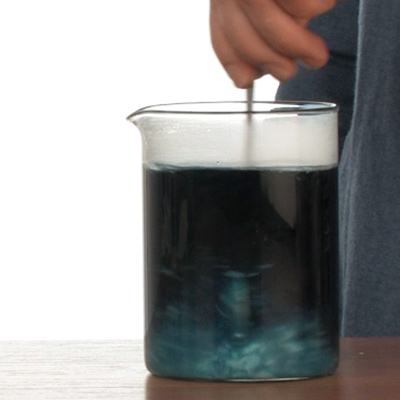
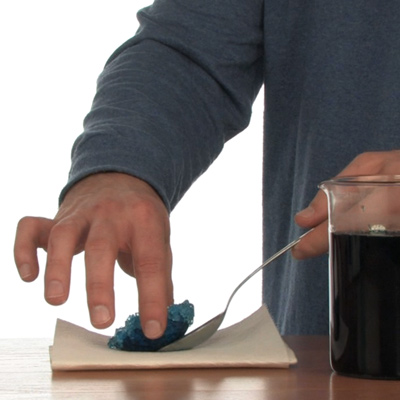

Can you put more than one egg shell in the solution at a time?
Hi Katie and Kristine – I’m not sure if half the water and half the alum will work or if you can put two shells in at a time. We only ran the experiment as it is listed above. Now it’s your turn to experiment and find out other tricks and ways to do it. Good luck and come back and let us know what you find out!
Kids were so excited that I forgot to let it cool off before placing eggs inside water. Hope it still works!!
I have also saved and rinsed out my cracked open eggshells (from homecooking)over a period of time to do this with my 75 students, I coated the inside of the eggshells with glue and glow-in-the-dark powder. Once dried, poured the alum solution into the half shells resting in the egg crates, waited a day or two and poured out residual liquid to find beautiful crystals within. The ‘geodes’ glow-in-the-dark and the kids loved it!~
Hi Katie,
Did you try putting more than one egg shell in the solution? If so, did it work?
We are just waiting for glue to dry!
Thanks,
tanya
Please note that your Alum Powder must be Potassium Aluminum Sulfate. I purchased Aluminum Sulfate also known as Alum Powder in bulk for my class, it does not grow crystals!! I now have 15 pounds of Aluminum Sulfate, worth fifty dollars, and I don’t have any ideas what to do with it along with a refrigerator full of eggs. Any ideas??
I do you can make aluminum boats and see how much alum it can hold and the winner will get a prize 🙂
love
im in the same boat too! 15 pounds for nothing!!
I feel so bad for you two who ordered the bulk and it didn’t work, but I thank you so much for posting that. I almost wasted money!
you may be able to use the alum powder to make play dough, check out recipes online that call for alum powder or donate it to a nearby preschool with the recipe for play dough
I tried this but all I ended up with was colored eggshells. After spending $30 on Alum powder for my class, is this all there is to it?! I followed the directions exactly 🙁
This is a VERY finicky experiment. You have to just keep trying it until it works. Doing it in small batches may be the best bet. We followed the steps above exactly, without variation, several times and got different results each time. The process does work…it just may take several tries and a lot of patience. Good luck!
this is not working…we redid this lab two times
does anybody know what the problem may be
thanks i would love some feedback
what is the brand of Alum used in this experiment (in the picture)? I only want to buy a small container of it, and that’s about the size I would like.
i want an hypothesis for this experiment you should put an hypothesis because in our school if i want to choose this experiment i have to have a hypothesis
Nooshin – What kind of hypothesis would you come up with for this experiment? Get creative and find a way to test this fun science demonstration.
Does the alum powder have to contain Potassium in it?..? Please answer
Hi – our experts aren’t sure if potassium is a key ingredient or not. This may be a great science fair project to determine its importance in the activity. We used alum powder purchased from grocery store in the spice section. That type will work just fine. You may need a little patience to get it to work correctly.
I need a good hypothesis question for doing this project to make geodes with eggs and allum powder. My daughter is in grade 6 so it would have to be a higher level prediction and a good question or purpose for her science fair project. Please comment on what level this experiment is. I can’t seem to change her mind but if somehow I can make this project or experiment more in depth or advanced then she would get a decent mark.
Thanks for helping.
Busy Mom
The best way to start on a science fair project is to ask a ‘What will happen if’ question and look at what can be changed…What will happen if I alter the amount of alum powder used to make egg geodes? What will happen if I use _____________ in place of alum powder? Will I get different results. Find a way to change the given directions that you know will work (this becomes your control) and work to answer your question. I hope this helps. Good luck with your project!
I ended up using regular bulk alum sulfate from nutters and I am very disappointed that I spent $45 and nothing happened. Should alum be potassium based to work? I am still confused about the hypothesis for her to use? Please help? I am running out of time and getting really frustrated with this. If I used 3 types of temp growth such as the fridge, room temp and heat but what kind of heat and what temperature. Desperate for answers.
Busy Mum
Hi – I am so sorry that you are frustrated with this experiment. It can be really frustrating to get it just right. This experiment needs a lot of patience and ability to try it until it works. I’m not sure if you need potassium in the alum. We just used the standard alum from the grocery store.
A hypothesis is an educational guess based on your test. So if you are testing different amounts of alum – your hypothesis would be a guess at the result. Which amount of alum will work to make the geode? And keep in mind that not getting any geodes is not a failure. That is the result of your experiment and you can report that. None of your tries worked. That’s the answer.
I hope this helps.
I finally got the experiment to work but it definitely took potassium alum to work. I don’t know how to help her regarding the application on her science fair board. How does her experiment making home-made Geodes apply to everyday life and how this can apply to some one else in real life. She did use 3 different temperatures as well to do her experiment(Heat, fridge and room). Can’t figure out what she needs to put.
Busy Mum
it works great did it for a science project got 1st place so it does work just keep trying
What kind of glue is required? Also, thank you for the tip, about the type of powdered alum to use! 😉
I think we just used basic Elmer’s white glue. Nothing special or expensive.
do you know the independent vairable of an egg geode please help thanks .
Hi Layla – An Independent variable is what is being changed in an experiment. The egg geode experiment can have several independent variables. What types of ingredients could you change in this experiment and test?
Alum Powder must be Potassium Aluminum Sulfate. Are you sure you have the right powder? Not Aluminum Sulfate?
We’ve used Alum powder that we purchased at the grocery store. It’s touchy and tricky but it will work.
Hi Susan. I know what the independent variable and control is but do you know mind telling me what the dependent variable would be for this project? Please reply. Thanks!
Lizzy – A dependent variable is the action that occurs in response to the changing independent variable… the measurement. How high did it go? How much did it change? You will compare your dependent variables to get your result.
Sorry I made a mistake and put ‘know’ in the middle of ‘do’ and ‘mind’.. Oops 🙂
Please reply. I have a science project due in 3 days and I need all the information typed and ready to put on a show board. Thank you.
i loved this project and it was really cool to make 🙂 i love this website
3rd try..followed diredtions…still no crystals. What am I doing wrong? Too late for this Easter but would like to try next year
Hi Brenda – this is a really touchy activity. It just takes a lot of patience and sometimes, a lot of tries. Good luck! Let us know if you have success.
how do you make and voncano out of glass
In your opinion, how would you say this experiment connects to the real world. Thanks, Jill Mackenzie